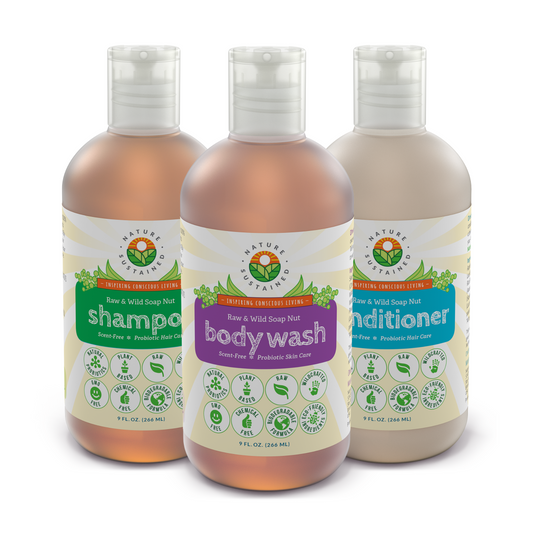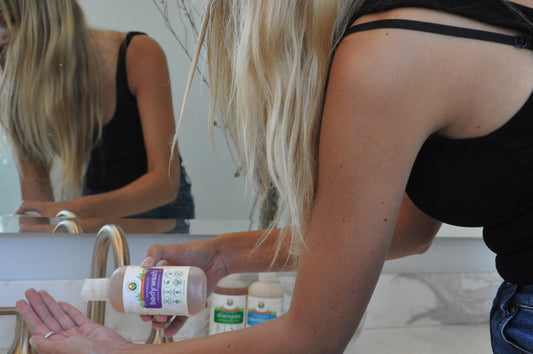
What does pH-balanced body wash mean?
Pasha KnishYour skin is as unique as you are. It can be oily, dry, normal, sensitive, or a combination of any of these types. When it comes to finding the right skin care products to keep your unique skin as healthy as possible, your skin’s pH level and using pH-balanced products are key.
But before we dive into what being pH-balanced has to do with skin care products like body wash, let’s first define pH. pH (potential hydrogen) refers to how much acid is in a substance, like our skin, for example. pH is measured on a scale of 1-14, with 7 being neutral, 1 being highly acidic (like battery acid) and 14 being highly alkaline (like bleach). But what does all this have to do with healthy skin and pH-balance? Read on.

What does pH balanced even mean when it comes to hair products?
Healthy adult skin has a pH level averaging from between 5.4-5.9 on that 1-14 scale, and this range is considered “pH-balanced.” But why is this so important? When the pH of your skin is kept in balance, which is a bit more acidic than neutral, this acidity allows your skin to feel moisturized, soft, and hydrated while fighting off free radicals and other harmful substances, often delaying the aging process and resulting in young, resilient, and healthy skin. And since your skin acts as a protector against the outside world, prevents moisture loss, helps regulate your body temperature, prevents sun poisoning, and allows you to touch and feel, keeping your skin healthy and pH-balanced is extremely important. It’s one of the main reasons our products are pH balanced. Your skin needs it!

What happens if your body wash is not pH balanced?
If the pH level of your skin isn’t kept at an optimal level on the scale, the health of your skin can be affected. So, if you use skin care products, like body wash, that are not pH-balanced, this can cause your skin to be unbalanced pH-wise. When this happens, it can damage your skin and hinder its protective roles in your body, causing dry and flaky skin, sensitive skin, skin inflammation, some skin conditions (like acne, eczema, and the different forms of dermatitis), and the increased growth of “bad” bacteria. And while you might just be thinking, “Well, I won’t put anything on my skin that puts it out of balance,” that’s easier said than done.
Anything you put on your skin, even water, that’s out of that pH-balanced range can mess up your skin’s pH balance very quickly. So, the key is to keep your skin in that pH-balanced range by using skin care products that are as close to being pH-balanced as possible.

Are most body wash products pH balanced?
Unfortunately, many skin and hair care products have higher pH levels than the optimal pH-balanced level of your skin, disrupting that pH balance like we talked about before.
In fact, many soaps and body washes have pH levels as high as 9-10. Since the normal pH range for your skin is between 5.4-5.9, it only makes sense that your body wash, which is used to clean the vast majority of your skin, should also be in that same pH range. Otherwise, you risk damaging your skin and negating its protective properties.
How do you know your body wash has the right pH?
Unfortunately, pH levels are not commonly placed on product labels. So, it can be difficult to know if your body wash is a good choice for your skin. Here are some things to think about when trying to find the correct body wash for your pH needs:
- When in doubt, call the customer service number for your product. If they can’t tell you the pH level of their body wash, that’s probably not the one for you.
- If a label says “pH-Balanced,” it doesn’t necessarily mean that it’s balanced per the pH balance 1-14 scale. So, always look for an exact number.
- If there are pH numbers in a product name, that doesn’t guarantee that product actually meets that pH number.
- Be wary of using Google to find pH balance numbers for products. Many are paid sponsorships, so they’re not totally trustworthy.
- Keep in mind that soap is known to have a high pH level, so try to choose other products, like body wash, for your skin cleansing needs.
- Purchase your products from trusted retailers (like us!) who are on a mission to make the best products for your skin.
If you’d like to test the pH levels of your body wash or any other skin care or hair care products, you can purchase pH test strips and test your products at home. Testing is simple: Simply wet the strip with the product, wait for it to develop, then compare the results against a key that come with the strips. Easy, peasy!
Another way to ensure your body wash is as close to being pH-balanced as possible is to buy products with all-natural ingredients. We’re very fond of our soap berry products since soap berries are known to have a natural pH of 5.5, which nurtures your skin rather than washing away all the natural oils and other protectants your skin needs to stay healthy. Since we create our soap berry products with zero chemicals and zero processing (which can damage the pH balance of an ingredient), you know you’re getting a product that helps lock in your skin’s moisture and prevent dryness and irritation, helping to maintain optimal pH levels naturally. And not only are our soap berry products good for your skin and pH-friendly, but they are earth-friendly as well. That’s a win all around.
When it comes to your skin and the products you put on your skin, understanding not only how products will affect your skin and your skin health but also what ingredients are in those products is key. “Ignorance is bliss” is not the way to go with skin care products. The more knowledge you have about what you’re putting on your skin, the better.








